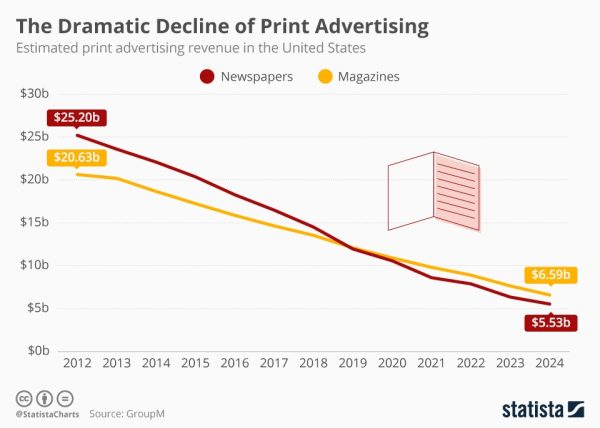From tabloids to TikTok, people have always found a way to spread the latest gossip and trends. Although the mode of relaying information has evolved over the centuries, the media has preserved the concept of entertaining news. Today, society tends to rely on information from digital platforms instead of print magazines. As a result, print tabloid sales have decreased significantly over the past ten years. The evolution of technology and digital media has permanently altered the landscape of information exchange as print media struggles to remain relevant.

The development of printing technology ignited a revolution of interest in print magazines and expanded its accessibility to a larger audience. Tabloid magazines trace their roots back to the 18th century and were pivotal for spreading gossip and entertaining news. The Sketch was the first major women’s socialite magazine, which the London News Company developed in 1893. The publication included information about theater and the arts, as well as gossip about Britain’s royals and aristocracy, according to lithub.com. Later, in the 1930s and 1940s, there was an influx in gossip columns due to new Hollywood fame from the growth in popularity of films and movie stars. Mr. Walter Winchell, an American tabloid journalist, published the famous gossip column “On Broadway,” which he filled with rumors and celebrity news similar to the modern-day tabloid US Weekly, according to shondaland.com.
From the 1970s to the early 2000s, celebrity gossip once again became more mainstream, and the magazine industry gained popularity for its print columns. At the same time, supermarkets began selling weekly tabloids about “hot gossip,” such as Hollywood celebrities and political conspiracies. The industry was peaking due to the rise in celebrity scandals, according to lofficielsingapore.com. Gossip magazines were culturally significant and influenced teenagers through their portrayals of lavish lifestyles.
As the publishing industry became a more popular career, producers began incorporating magazines into films. For example, The Devil Wears Prada is a successful movie about the struggles of working for Vogue magazine because of the highly competitive and fast-growing industry. Other movies that drew influence from the booming magazine business include How to Lose a Guy in 10 Days and 13 Going On 30. The success of these movies, in turn, was instrumental in the rise of tabloids and fashion magazines, as they glamorized everyday life and work in the magazine industry.
Although magazines maintained their popularity into the early 2000s, print tabloids began to decline as information and media became easily accessible online. In 2005, Mr. Harvey Robert Levin founded Thirty-mile Zone (TMZ), an online source for tabloid-style stories. TMZ was the first major company to offer an online tabloid, shifting the print magazine industry forever.
As social media users continue viewing digital platforms as news and entertainment sources, print magazines struggle to retain consumers’ attention. Online videos, such as those from TikTok, as well as other forms of digital entertainment journalism, such as blogs, provide more time-efficient gossip while remaining eye-catching. Tabloids cannot keep up with the amount of online production across various social media platforms. In addition, celebrities now reach their fans with social media such as Instagram, Twitter, and Snapchat. These platforms allow them to converse with and develop a newfound loyalty and trust within their fans as they can relate to them more deeply through social media.
As technology and communication develop, newer generations have recognized the logic of investing in online content rather than waiting for new print publications. For media outlets, the cost of printing 100,000 issues of the latest magazines is more than the revenue coming back. Between 2019 and 2022, total audiences for magazine companies decreased by 38.56 percent, according to wordsrated.com. Digital newspapers and magazines worldwide, however, are projected to reach a revenue of $40.23 billion by 2024, according to statista.com.

Since print magazines are on the decline due to digital media, publishers recognize that their companies must get information out faster online to succeed in the industry. Tabloids such as Glamour and Health are changing their formats to elevate their magazines and shifting toward social media to attract a younger audience, according to fashionista.com. Mr. Neil Vogel, the chief executive of Dotdash Meredith, the owner of various digital media companies such as InStyle magazine, discussed the company’s decision to end the print edition of InStyle due to the benefits of a digital-only magazine.
“It is not news to anyone that there has been a pronounced shift in readership and advertising from print to digital, and as a result, for a few important brands, print is no longer serving the brand’s core purpose,” Mr. Vogel said, according to The New York Times. “As such, we are going to move to a digital-only future for these brands, which will help us to unlock their full potential.”
Another popular women’s magazine, Allure, which has produced print tabloids since 1991, halted its print publications and switched to an entirely remote format. The brand was not selling enough print copies of its magazine and had a more substantial presence online. Other magazines that have also shifted from print to digital include Entertainment Weekly, EatingWell, Parents, People en Español, and Teen Vogue, according to fashionista.com.
Print brands are beginning to evolve as they adapt to online platforms. For example, Sora, an ebook library, makes magazines, newspapers, and books more available and allows students to read newspapers at home. As a result, students now prefer conducting online research rather than reading textbooks from the library. Educational media enhances understanding and engagement, making it appealing for students. It allows students to access resources at their own pace and convenience. The majority of students, precisely 69 percent, prefer utilizing YouTube videos for learning, and 50 percent of schools now use social media accounts to engage students in learning, according to gitnux.org.
The Sacred Heart Greenwich library allows access to online databases for all subjects. This change enables students to complete research conveniently from home on their computers, eliminating the need to visit the library every day. Mrs. Olivia Kolenberg, Upper School Librarian, spoke about the advancements digital media has introduced for education.
“There are so many digital resources that are useful in school. For example, library research is a lot easier because of the number of databases accessible,” Mrs. Kolenberg said. “As digital media has become more available, it is now unnecessary to have a giant encyclopedia. With the advancements of the internet and technology, there is an endless number of improvements that can help education.”
Featured Image by Ellie Furman ’26




